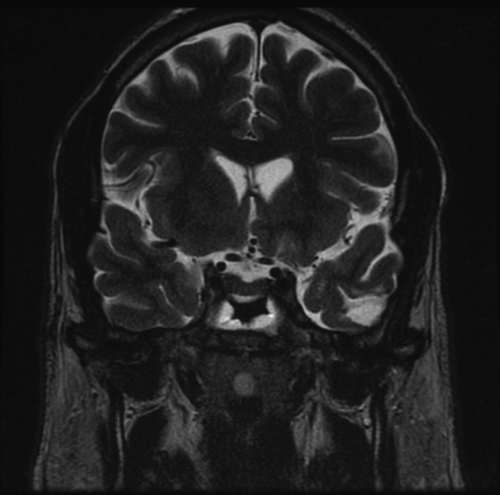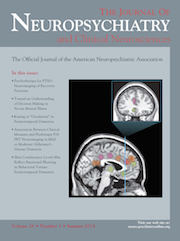A Case of Acute-Onset Partial Kluver-Bucy Syndrome in a Patient With a History of Traumatic Brain Injury
To the Editor: Kluver-Bucy syndrome is a rare disorder characterized by visual agnosia, placidity, bulimia, hypersexuality, hyperorality, and memory deficits caused by lesions of the amygdala. In addition to systemic diseases and infections, traumatic brain injury is known to cause Kluver-Bucy syndrome. We present a case of partial Kluver-Bucy syndrome that developed following a fall from height in a patient with a history of traumatic brain injuries.
Case Report
“CD” was a 39-year-old man with no past psychiatric history who presented to the emergency department after falling from a ladder. The patient lost consciousness at the scene and complained of nausea, blurry vision, and headache on initial evaluation. Noncontrast head CT and toxicology screen were negative. The patient admitted to a history of several closed head injuries, although he never sought medical attention. In the emergency department, he became acutely agitated and was ultimately admitted for psychiatric observation.
Throughout the admission, there were instances when he spoke to himself, but he did not appear to attend to internal stimuli and he denied auditory or visual hallucinations. His mood was euthymic, although his affect was noticeably blunted. He had deficits on short-term memory, and each day he had to be reintroduced to his physician. The patient demonstrated marked hypersexuality in the form of inappropriate remarks, attempts to touch female staff members, and frequent daily masturbation. He also exhibited hyperphagia; regularly taking multiple full plates with meals.
MRI of the brain revealed a signal abnormality in the inferior left temporal lobe compatible with remote traumatic brain injury (Figure 1). His EEG was normal with no epileptiform discharges.

The patient was initially started on risperidone 1 mg twice daily for a tentative diagnosis of psychotic disorder not otherwise specified. After nearly a week of antipsychotic pharmacotherapy, there was no improvement noted in his symptoms. As the hypersexuality, bulimia, placidity, and memory deficits became apparent, he was transitioned to carbamazepine 400 mg twice daily, which produced significant improvement in symptoms.
Discussion
There are many documented cases of Kluver-Bucy syndrome following traumatic brain injury, although most are associated with severe neurologic deficits as evidenced by a depressed Glasgow Coma Scale.1,2 In review of the literature, there was one other report associated with a unilateral brain lesion following minor head trauma.3 In that case, the symptoms were mild and transient and resolved without pharmacologic intervention.
This case is unique in that the acute onset of partial Kluver-Bucy syndrome occurred in the setting of old MRI lesions and a history of closed head injuries. There is no literature regarding the cumulative effects of repeated traumatic brain injury on the development of Kluver-Bucy syndrome. Bhat et al. reported a case of Kluver-Bucy syndrome that presented after remote traumatic brain injury and responded to carbamazepine.4 Based on experiments with the rat model, it is hypothesized that repeat injury and subsequent chronic neuronal degeneration could theoretically lower the threshold for the development of Kluver-Bucy syndrome.5
1 : Klüver-Bucy syndrome in man: experiences with posttraumatic cases. Neurosci Biobehav Rev 1983; 7:413–417Crossref, Medline, Google Scholar
2 : The human Klüver-Bucy syndrome. Neurology 1983; 33:1141–1145Crossref, Medline, Google Scholar
3 : Klüver-Bucy syndrome as a result of minor head trauma. South Med J 2002; 95:929–931Crossref, Medline, Google Scholar
4 : Partial Kluver-Bucy syndrome as a delayed manifestation of head injury. Ind Psychiatry J 2009; 18:117–118Crossref, Medline, Google Scholar
5 : Progressive atrophy and neuron death for one year following brain trauma in the rat. J Neurotrauma 1997; 14:715–727Crossref, Medline, Google Scholar



